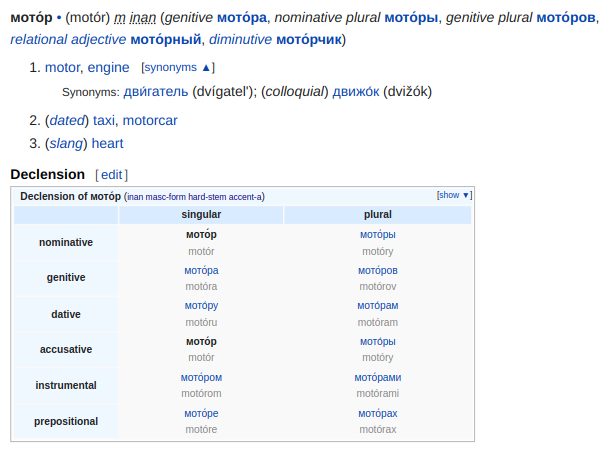Stress patterns of Russian nouns: A method for stress-free memorization

You first have to produce bad ideas to come to good ones*
Endtroducing
In Russian, the stress (accent) can fall either on the stem or on the ending of a noun. The stress can vary for a same noun based on grammatical number (singular/plural) and sometimes even case. How to make sense of these stress patterns and how to best memorize them?
I would like to offer a possible answer in this article by presenting my personal approach, in the hope that it can inspire some or prompt some to inspire me (some) by suggesting even simpler approaches or pointing out some logic I missed.
The solution I propose is to memorize a few forms (declensions) of the noun we are learning — though only specific forms, and just as few as needed in order to deduce the stress patterns, based on a system we created.
This method has the advantage of requiring you to memorize very little information (very few declensions) for the most common stress patterns; and a bit more — but still little information — for less common stress patterns. Additionally, what you will memorize is directly relevant to your speaking — as you only memorize actual declensions of the noun, not any random bit of information.
(Insert paywall here.)
Context needed
As shown on this very insightful Wiktionary page, each noun’s stress pattern is one of ten alternatives.
We can know the stress for all declensions of a given noun (as well as the noun’s stress pattern type — should it interest us) by looking up the noun on Wiktionary and expanding the “Declension” section. For example, for мотор, we find all of its declensions, as well as its stress pattern type (a (accent-a)) at the top of the table:
Efficiency tangent: I like to add the Wiktionary’s Russian section (
https://en.wiktionary.org/wiki/%s#Russian) as search engine on my web browser and assign a keyword to it; this way I can simply type, for example,wkr моторin my web browser’s address bar to jump to its entry in Wiktionary — and quickly check its declensions if I have a doubt.
Bonus tip: Use a web browser extension for custom stylesheets (e.g. Stylus on Google Chrome) and add
.NavFrame .NavContent { display: block !important; }as custom style for Wiktionary pages to show tables by default (including the “Declensions” table) — so that you don’t have to click “show” each time. I use similar methods to hide the homepage, suggested videos, comments and likes on YouTube; the news feed, likes and new notifications on Facebook; album ratings on Wikipedia; and more.
I now proceed to explain the thought process or logic behind the “design decisions” of the system we are coming up with. This can be skipped — though you would miss an opportunity to correct my faulty reasoning.
We want to have to memorize as little information as possible when learning words with the most common stress patterns. We want the most common stress patterns to be our “default” — to be what is assumed when we are not providing any extra information.
The most common patterns being a, b, c and d (in the first picture) — that is, with the stress falling on the same place for all singular cases, and on the same place for all plural cases — we can decide that memorizing the nominative singular form and the nominative plural form, when no piece of information is added to what we are memorizing, means that all singular cases follow the same stress as the nominative singular, and all plural cases follow the same stress as the nominative plural
In that case, we would for example memorize учи́тель,учителя́ as the back of a flashcard reading “teacher”. This would mean that all singular forms follow the same stress as the nominative singular (in this case, on the stem), and all plural forms follow the same stress as the nominative plural (in this case, on the ending).
Additionally, because a stress falling on the last syllable of the nominative singular can be ambiguous (as it could mean either that the stress is on the stem (e.g. мото́р, genitive singular мото́ра) or the ending (e.g. язы́к, genitive singular языка́)), and because the stress patterns a and b are the most common — whereby the stress is the same for both singular and plural forms (and the same for all cases) — we can make it our “default” that, unless extra information is given, in case of such an ambiguous case, we assume a stress pattern whereby the stress is the same for all cases and all grammatical numbers.
For example, we would memorize мото́р,мото́ры as the back of a card reading “motor”; the nominative singular “мото́р” could mean that the stress is either on the stem or on the ending for the singular, but since the stress in the nominative plural is on the stem, and no extra information is given, we can assume that the stress is on the stem for all cases and grammatical numbers of this noun. Likewise, we would memorize грузови́к,грузовики́ for “truck” and assume that the stress is on the ending for all forms and grammatical numbers.
Now, when about what what about when the stress in the nominative case is different from the stress in other cases for a given grammatical number (stress pattern types e and f in the first picture)? In that case, we need to specify and memorize this non-intuitive extra bit of information. We can do so by memorizing another declension of the word just after the nominative of that grammatical number — I like to use the prepositional for that purpose across the whole system. For example, слеза́,слёзы(слеза́х) lets us know that the stress is on the ending for all singular cases; on the stem for the nominative plural, and on the ending for all other plural cases. Likewise, гво́здь(гвозде́),гво́зди(гвоздя́х) signifies that the stress is on the stem for the nominative singular, on the ending for the other singular cases; on the stem for the nominative plural, and on the ending for the other plural cases.
I do the same to override our rule about assuming the same stress across all cases and grammatical numbers in ambiguous cases, for example when the stress is on the last syllable in the nominative singular and nominative plural. Thus, пи́р(пи́ре),пиры́ means that the stress in the singular is on the stem for all cases; and in the plural on the ending for all cases.
This brings us to the b’, d’ and f’’ stress patterns, which each have, for a given grammatical number, a specific case (other than nominative) with a stress different from the other cases. In that case, I like to memorize the edge case also just after the nominative form. I can tell this exceptional form apart from a form used to inform us of the standard stress pattern for a given grammatical number (as in the last example) because the exceptional form is not in the prepositional — as exceptional stress cases only occur in the accusative singular or instrumental plural. An example to memorize a word with such an exceptional declension would then be душа́(ду́шу),ду́ши, which means that the stress is on the ending for all singular cases, except ду́шу (accusative); and the stress is on the stem for all plural cases. Likewise, гру́дь(гру́дью,груди́),гру́ди(грудя́х) means that the stress is on the stem for the nominative singular and instrumental singular, and on the ending for all other singular cases; and that the stress is on the stem for the nominative plural, and on the ending in all other plural cases.
We have now covered all stress pattern types. It could be useful at this point to summarize how to deduce a stress pattern from the memorized forms.
Useful summary
Here is a key to interpret the syntax we have come up with. The syntax is formally <nominative singular declension>(<?exceptional singular case declension>)(<?prepositional singular declension>), <nominative plural declension>(<?exceptional plural case declension>)(<?prepositional plural declension>)> where “?” marks an optional item.
- If the nominative singular (resp. plural) is provided without additional singular (resp. plural) cases, all singular (resp. plural) cases have the same stress as the nominative singular (resp. plural) (e.g.
учи́тель,учителя́). - In the ambiguous case that the stress is on the last syllable in the nominative singular, which could mean either stress on the stem or the ending, we assume that the stress is the same type as the nominative plural (e.g.
язы́к,языки́(stress on ending everywhere);мото́р,мото́ры(stress on stem everywhere)). - If a prepositional declension is provided after the nominative singular (resp. plural), all other singular (resp. plural) cases follow the same stress as the prepositional. (e.g.
слеза́,слёзы(слеза́х)(singular: stress on ending; plural: stress on stem for nominative, ending on rest); e.g.гво́здь(гвозде́),гво́зди(гвоздя́х)(singular: stress on stem for nominative, ending on rest; plural: stress on stem for nominative, ending on rest)) - If a declension other than prepositional is provided after the nominative, it signifies an exceptional declension. The prepositional declension can still follow this exceptional declension to dictate the stress of the remaining singular (resp. plural) cases, in case they differ from the stress of the nominative singular (resp. plural). (e.g.
душа́(ду́шу),ду́ши(singular: stress on the ending, except for the accusative; plural: stress on the stem); e.g.гру́дь(гру́дью,груди́),гру́ди(грудя́х)(singular: stress on the stem in the nominative, exceptional case “гру́дью” (instrumental), stress on the ending in the other cases; plural: stress on the stem in the nominative, on the ending in the other cases))
As an appendix, I will post again the table from the beginning along with what we would have to memorize for the example word given, using the system we’ve created.
Case closed.
(Also a great anime.)
Please feel free to contact me to suggest improvements, tweaks or other approaches!

